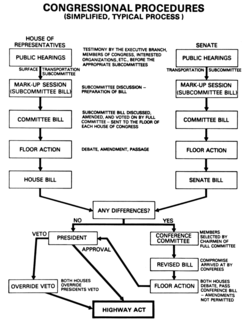tions and the limited need for detailed Federal involvement.
The operational system or technical administration of the physical program is only half of the story of the management of the Federal-aid highway program. Since the Federal agency is responsible for protecting the Federal Government’s investment in the highway program, the other half is concerned with the financial management of funds and the accounting for expenditures. This, too, involves very complex procedures that are not independent of the operational system procedures.
Financial Management
The system that has evolved over the years for authorizations, apportionments among the States, and the overall funding of the Federal-aid highway program has been prescribed largely by the Federal legislation. While it was developmental in the sense that its concepts were developed in bits and pieces, the basic rules or principles were established early in the history of Federal-aid legislation. The one major new element was the creation of the Highway Trust Fund in 1956.
The ground rules used in the legislative and financial administration of the program comprise the steps, principles, authorities, and limitations that must be followed in administering, or managing, the Federal-aid highway funds that are made available by congressional legislation. The system is integrally related to the operational system; i.e., the technical administration of the physical program.
The system for the financial administration of the Federal-aid highway program is unique in relation to most other Federal assistance programs in that it has recognized that the States must know what to expect from the Federal Government with a substantial lead-time to provide for their own adequate legal, fiancial, and administrative planning.

The legislative process has not changed much over the years. The Administration submits its proposed program to Congress and individual members of Congress may also submit bills. Extensive committee hearings are held, and eventually the House and Senate committees develop and report out proposed bills for consideration by the whole Congress. Differences are resolved by conference committee made up of members of both Houses. After final approval by both the House and the Senate, the bill is sent to the President for signature which constitutes enactment.
Traditionally, the Administration has submitted its proposed highway legislation to Congress shortly after the first of each even-numbered year. This was an endeavor on the part of Congress to assist the States in their planning for participation in the program, since most State legislatures convene on a biennial basis in the odd-numbered years. Thus the coming availability of Federal funds to the States was known in advance so that the State legislatures could provide their highway moneys, including the State matching funds and the advance funds which the States needed to first pay highway contractors and which would be later reimbursed from the Federal Government.
The committee hearings usually have been initiated in Congress in the spring, and the highway act is usually enacted any time from early summer to the end of the year. Over the years, there have been exceptions to this timing, but the pattern has been fairly consistent.
When the 1916 and 1921 Highway Acts were passed, they appropriated funds for the new highway program. This appropriated money had specific limitations as to amount, purpose, and duration. In addition, these Acts specified that a percentage of the appropriation was to be set aside for administering the program and for research. It also specified how the money was to be apportioned, or divided, among the States based on a prescribed formula in the law. By appropriating the funds, Congress provided budget authority which allowed the Bureau to incur obligations (a commitment by the Bureau to pay out the money).
After a State received its certificate of apportionment from BPB telling it how much money the Federal Government was committing for its use, the State was free to go ahead with obligations for work to be performed. When the Project Agreement had been executed and signed by the Secretary of Agriculture, the Secretary notified the Treasury Department, and the money was thus reserved for payment of the State’s voucher when received and approved by the Bureau of Public Roads.
The Post Office Appropriation Act for fiscal year 1923 did not appropriate any funds directly because it only “authorized [sums] to be appropriated.” This was the beginning of contract authority for the Federal-aid highway program which permitted obligations of the full authorized amounts before any legislation had been passed to provide liquidating cash to pay the
